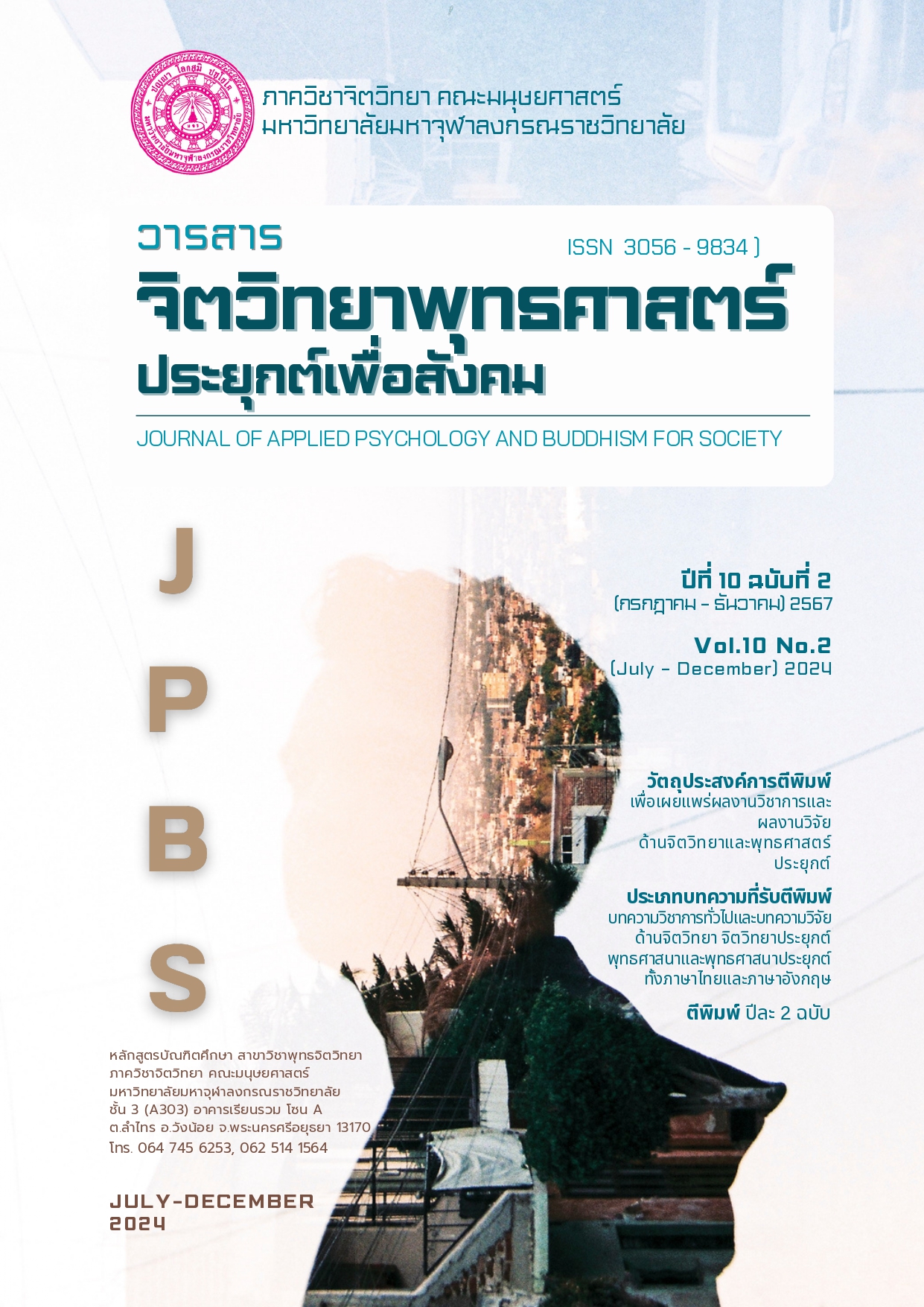The Effects of the Capacity Development Program to Active Aging of the elderly at Chiang Rak Noi Sub-District Municipality Elderly School, Bang Pa-in District, Phra Nakhon Si Ayutthaya Province
Keywords:
Deveopment, Potential, Vitality, Elderly People, Elderly SchoolAbstract
This research aims to study the effects of a development program designed to enhance the vitality of elderly people at the Chiang Rak Noi Senior Citizens School, located in Bang Pa-in District, Phra Nakhon Si Ayutthaya Province. The research employed a quasi-experimental design with a one-group pretest-posttest approach. The population consisted of elderly individuals at the Chiang Rak Noi Senior Citizens School, and the sample included 41 elderly participants selected through purposive sampling based on specific criteria. The research tools included: 1.a 12-week elderly development program to enhance vitality, consisting of 5 activities: Activity 1: Knowledge on aging and changes in elderly life, Activity 2: Physical well-being, Activity 3: Mental well-being, Activity 4: Social well-being, Activity 5: Cognitive well-being, and Activity 6: Spiritual well-being; 2. an assessment questionnaire for evaluating elderly vitality developed by the Thai Elderly Research and Development Foundation, consisting of 25 items across 5 domains: physical, mental, intellectual and learning, social, and security, with pre- and post-program evaluations; and 3. an individual happiness record. Data were analyzed using descriptive statistics, including frequency distribution, percentage, mean, and standard deviation, using computer software.
The results showed that: 1.The average vitality score of the participants, as measured by the Paired t-test, increased significantly after the program. The post-program mean score was 80.37 (M=80.37, SD=3.21), compared to 66.12 (M=66.12, SD=3.87) before the program, with a statistically significant difference (t= -17.66, p<.001). 2.The evaluation of overall vitality levels of the elderly revealed that after the program, their vitality level was rated at level 4, indicating a high level, compared to a pre-program rating of level 3, indicating a moderate level. The new knowledge gained from this study highlights the improvement in elderly potential, increased vitality, and enhanced community relationships, which contributed to better well-being among the elderly.
References
กองส่งเสริมศักยภาพผู้สูงอายุ กรมกิจการผู้สูงอายุ. (2559). คู่มือผู้สูงอายุ. กรุงเทพฯ : กระทรวงการพัฒนาสังคมและความมั่นคงของมนุษย์.
กรมสุขภาพจิต. (2565). คู่มือความสุข 5 มิติสำหรับผู้สูงอายุ. กรุงเทพฯ : โรงพิมพ์ชุมนุมสหกรณ์การเกษตรแห่งประเทศไทยจำกัด.
จันทนา สารแสง. (2561). คุณภาพชีวิตและพฤติกรรมส่งเสริมสุขภาพของผู้สูงอายุ ตำบลทุ่งข้าวพวง อำเภอเชียงดาว จังหวัดเชียงใหม่ (วิทยานิพนธ์สาธารณสุขศาสตรมหาบัณฑิต). มหาวิทยาลัยราชภัฏเชียงใหม่. เชียงใหม่.
พินิจ ฟ้าอำนวยผล. (2561). รายงานฉบับสมบูรณ์ การวิจัยทบทวนตัวชี้วัดและระบบข้อมูลเพื่อติดตามประเมิน Active ageing สำหรับประเทศไทย ภายใต้แผนงานบริหารจัดการโครงการวิจัยท้าทายไทย กลุ่มเรื่อง Active and Productive ageing. กรุงเทพฯ : สำนักงานคณะกรรมการวิจัยแห่งชาติ.
พูลศักดิ์ หอมสมบัติ และคณะ. (2565). โรงเรียนผู้สูงอายุ : การเสริมสร้างศักยภาพผู้สูงอายุในสังคมสูงวัย. วารสารนวัตกรรมการศึกษาและการวิจัย, 6(2), 540-551.
มินตรา สาระรักษ์, ฐิติรัช งานฉมัง และ นันทยา กระสวยทอง. (2563). ภาวะสุขภาพและพฤติกรรมสุขภาพของผู้สูงอายุ ตำบลคำขวาง อำเภอวารินชำราบ จังหวัดอุบลราชธานี. ศรีนครินทร์เวชสาร, 3(3), 304-310.
สำนักนโยบายและยุทธศาสตร์ กระทรวงสาธารณสุข. (2564). สถิติสาธารณสุข พ.ศ.2563 /Public health statistics A.D. กรุงเทพฯ : โรงพิมพ์สามเจริญพาณิชย์ (กรุงเทพ) จำกัด.
Cattan, M., White, M., Bond, J., & Learmouth, A. (2005). Preventing social isolation and loneliness among older people: A systematic review of health promotion interventions. Ageing & Society, 25(1), 41-67.
Chen, Y., & Feeley, T. H. (2014). Social support, social strain, loneliness, and Well being among older adults: An analysis of the Health and Retirement Study. Journal of Social and Personal Relationships, 31(2), 141-161.
Fratiglioni, L., Paillard-Borg, S., & Winblad, B. (2004). An active and socially integrated lifestyle in late life might protect against dementia. The Lancet Neurology, 3(6), 343-353.
Hawkley, L. C., & Cacioppo, J. T. (2010). Loneliness matters: A theoretical and empirical review of consequences and mechanisms. Annals of Behavioral Medicine, 40(2), 218-227.
McAuley, E., Blissmer, B., Marquez, D. X., Jerome, G. J., Kramer, A. F., & Katula, J. (2000). Social relations, physical activity, and well-being in older adults. Preventive Medicine, 31(5), 608-617.
Downloads
Published
How to Cite
Issue
Section
Categories
License
Copyright (c) 2024 Journal of Applied Psychology and Buddhism for Society

This work is licensed under a Creative Commons Attribution-NonCommercial-NoDerivatives 4.0 International License.





